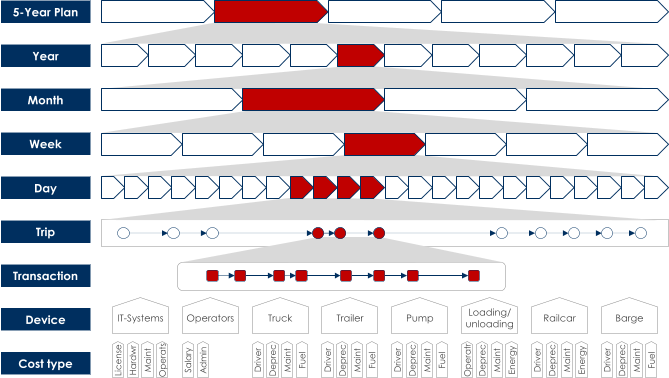

- Value Chain Excellence
- Company Business Performance
- Supply Chain Performance
- Supply Chain Strategy
- Integrated business management (S&OP)
- Digital Transformation
- Operational Improvement
- Transparency
- Complexity
- Agility
- Responsiveness
- Customer Needs
- Delivery Reliability
- SC Segmentation
- Inventory optimization
- Throughput Times
- Order Management
- Planning Excellence
- Cost management
- Logistics Cost
- Working Capital Optimization
- Supplier Optimization
- Transport Optimization
- Network Optimization
- Post Merger Integration
LOGISTICS COST OPTIMIZATION
In a supply chain, there are always two main focus areas for
cost optimization
•
In our assessments, we look initially at all relevant areas to
optimize logistics cost - but only on a very high level, to
understand the mechanics of the business, and the current
performance levels of our client.
•
Based on these high level insights, we develop a deeper
understanding what drives the logistics cost, and from there
to look into the two main levers for optimizing logistics cost.
•
The two main levers are factor cost (spend per unit), and
avoiding unnecessary cost. We prefer the second lever, as
the first one is already exploited based on decades of
purchase price optimization. But we also often run into the
need to have a fresh look at the first one…
•
By using a modified “Activity Based Costing” approach, we
can clearly identify the areas of factor cost influence (the
device and cost type levels), and the transaction levels
which drive how much of the cost is created.
•
The model also allows to see how often the transactions
happen, in a similar way, or in different ways, in different time
buckets. On that basis it is possible to identify other sets of
measures to influence the cost position - and also the
performance position.
•
When having created such a high-level transparency with a
very detailed backing of information, a wide range of
possible improvements can be identified, quantified, and
evaluated in their performance impact.

Logistics, Transport, and Distribution
networks offer plenty of opportunities for
improvement
•
There are many topics in logistics which
offer opportunities for improvement. This
is driven by the many participants,
interactions, and processes along the
logistics chain.
•
Typical strategic topics cover distribution
network design, number and role of
warehouses, selection of transportation
service providers and their given roles,
outsourcing of warehouse services, and
collaboration with sales and distribution
channels. There are many themes and
approaches, and every company will
need a different perspective and set of
improvements at a different point in
time. Therefore individual analysis, and
approach design, is a key driver for
performance enhancements
•
On the operational and transactional
level, the nature of improvements is
different - besides optimizing how a task
is conducted, the initial question should
be how to avoid the necessity to do this
task. Or to do it in a completely different
way. A core driver of logistics cost is the
number of transactions - the higher the
transaction volume, the higher the cost.
Although often economies of scale
apply, the starting question is often to
understand what drives the number of
transactions. And if a lot of emergency
shipments are due to late availability of
the parts, it is not a question of logistcs
cost per se…
•
Processes meet technology - a very
large part of improvements, and
changes to current setups and
infrastructures, resides in the new abilities
derived from clever IT systems, used in a
clever way. The magic of “digital
transformation” is very visible in this
space, even including the potentials of
3D-Printing, and other technologies
which reshape how products get to
customers. Or even when digital
products replace physical products
(music, photos, videos etc).















